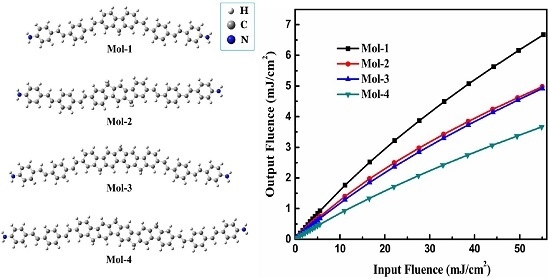Conjugation Length Effect on TPA-Based Optical Limiting Performance of a Series of Ladder-Type Chromophores
Abstract
:1. Introduction
2. Theoretical Methods and Computational Details
2.1. Ab Initio Calculations
2.2. Rate Equations for a Three-Level System
2.3. Field Intensity Equation
2.4. Dynamical TPA Cross Section
2.5. Computational Details
3. Results and Discussion
3.1. Temporal Evolution of the Pulse
3.2. Optical Limiting
3.3. Dynamical TPA Cross Section
4. Conclusions
Acknowledgments
Author Contributions
Conflicts of Interest
References
- Naseema, K.; Manjunatha, K.B.; Sujith, K.V.; Umesh, G.; Kalluraya, B.; Rao, V. Third order optical nonlinearity and optical limiting studies of propane hydrazides. Opt. Mater. 2012, 34, 1751–1757. [Google Scholar] [CrossRef]
- Yao, C.B.; Zhang, Y.D.; Chen, D.T.; Yin, H.T.; Yu, C.Q.; Li, J.; Yuan, P. Study of all-optical switching and optical limiting properties in phenoxy-phthalocyanines liquid. Opt. Laser Technol. 2013, 47, 228–231. [Google Scholar] [CrossRef]
- Zhu, J.H.; Li, Y.X.; Chen, Y.; Wang, J.; Zhang, B.; Zhang, J.J.; Blau, W.J. Graphene oxide covalently functionalized with zinc phthalocyanine for broadband optical limiting. Carbon 2011, 49, 1900–1905. [Google Scholar] [CrossRef]
- Feng, M.; Zhan, H.; Chen, Y. Nonlinear optical and optical limiting properties of graphene families. Appl. Phys. Lett. 2010, 96, 033107. [Google Scholar] [CrossRef]
- Ma, H.; Leng, J.C.; Liu, M.; Zhao, L.N.; Jiao, Y. Two-photon absorption and optical limiting of a fluorenyl-based chromophore with femtosecond laser pulse. Opt. Commun. 2015, 350, 144–147. [Google Scholar] [CrossRef]
- Xu, H.; Song, Y.L.; Meng, X.R.; Hou, H.W.; Tang, M.S.; Fan, Y.T. Strong optical limiting effects of two Ag(I)-bridged metal-organic polymers. Chem. Phys. 2009, 359, 101–110. [Google Scholar] [CrossRef]
- Liu, J.C.; Wang, C.K.; Gel’mukhanov1, F. Optical limiting of short laser pulses. Phys. Rev. A 2007, 76, 053804. [Google Scholar] [CrossRef]
- Tutt, L.W.; Boggess, T.F. A review of optical limiting mechanisms and devices using organics, fullerenes, semiconductors and other materials. Prog. Quantum Electron. 1993, 17, 299–338. [Google Scholar] [CrossRef]
- Chang, Y.C.; Chiou, A.E.; Khoshnevissan, M. Linear and two-photon absorptions of Si–Ge strained-layer superlattices. J. Appl. Phys. 1992, 71, 1349–1360. [Google Scholar] [CrossRef]
- He, G.S.; Reinhardt, B.A.; Bhatt, J.C.; Dillard, A.G.; Xu, G.C.; Prasad, P.N. Two-photon absorption and optical-limiting properties of novel organic compounds. Opt. Lett. 1995, 20, 435–437. [Google Scholar] [CrossRef] [PubMed]
- Price, R.S.; Dubinina, G.; Wicks, G.; Drobizhev, M.; Rebane, A.; Schanze, K.S. Polymer monoliths containing two-photon absorbing phenylenevinylene platinum(II) acetylide chromophores for optical power limiting. ACS Appl. Mater. Interfaces 2015, 7, 10795–10805. [Google Scholar] [CrossRef] [PubMed]
- Varnavski, O.; Yan, X.Z.; Mongin, O.; Desce, M.B.; Goodson, T. Strongly interacting organic conjugated dendrimers with enhanced two-photon absorption. J. Phys. Chem. C 2007, 111, 149–162. [Google Scholar] [CrossRef]
- Tian, Y.Q.; Chen, C.Y.; Cheng, Y.J.; Young, A.C.; Tucker, N.M.; Jen, A.K.Y. Hydrophobic chromophores in aqueous micellar solution showing large two-photon absorption cross sections. Adv. Funct. Mater. 2007, 17, 1691–1697. [Google Scholar] [CrossRef]
- He, G.S.; Tan, L.S.; Zheng, Q.D.; Prasad, P.N. Multiphoton absorbing materials: Molecular designs, characterizations, and applications. Chem. Rev. 2008, 108, 1235–1330. [Google Scholar] [CrossRef] [PubMed]
- Belfield, K.D.; Bondar, M.V.; Hernandez, F.E.; Przhonska, O.V. Photophysical characterization, two-photon absorption and optical power limiting of two fluorenylperylene diimides. J. Phys. Chem. C 2008, 112, 5618–5622. [Google Scholar] [CrossRef]
- Zheng, Q.D.; He, G.S.; Prasad, P.N. π-conjugated dendritic nanosized chromophore with enhanced two-photon absorption. Chem. Mater. 2005, 17, 6004–6011. [Google Scholar] [CrossRef]
- Li, C.W.; Yang, K.; Feng, Y.; Su, X.Y.; Yang, J.Y.; Jin, X.; Shui, M.; Wang, Y.X.; Zhang, X.R.; Song, Y.L.; et al. Investigation of two-photon absorption induced excited state absorption in a fluorenyl-based chromophore. J. Phys. Chem. B 2009, 113, 15730–15733. [Google Scholar] [CrossRef] [PubMed]
- Reinhardt, B.A.; Brott, L.L.; Clarson, S.J.; Dillard, A.G.; Bhatt, J.C.; Kannan, R.; Yuan, L.; He, G.S.; Prasad, P.N. Highly active two-photon dyes: Design, synthesis, and characterization toward application. Chem. Mater. 1998, 10, 1863–1874. [Google Scholar] [CrossRef]
- Jacob, J.; Sax, S.; Gaal, M.; List, E.J.W.; Grimsdale, A.C.; Müllen, K. Afully aryl-substituted poly(Ladder-type pentaphenylene): A remarkable stable blue-light emitting polymer. Macromolecules 2005, 38, 9933–9938. [Google Scholar] [CrossRef]
- Laquai, F.; Mishra, A.K.; Ribas, M.R.; Petrozza, A.; Jacob, J.; Akcelrud, L.; Müllen, K.; Friend, R.H.; Wegner, G. Photophysical properties of a series of poly(ladder-type pentaphenylene)s. Adv. Funct. Mater. 2007, 17, 3231–3240. [Google Scholar] [CrossRef]
- Jacob, J.; Sax, S.; Piok, T.; List, E.J.W.; Grimsdale, A.C.; Müllen, K. Ladder-type pentaphenylenes and their polymers: Efficient blue-light emitters and electron-accepting materials via a common intermediate. J. Am. Chem. Soc. 2004, 126, 6987–6995. [Google Scholar] [CrossRef] [PubMed]
- Zheng, Q.D.; Gupta, S.K.; He, G.S.; Tan, L.-S.; Prasad, P.N. Synthesis, characterization, two-photon absorption, and optical limiting properties of ladder-type Oligo-p-phenylene-Cored Chromophores. Adv. Funct. Mater. 2008, 18, 2770–2779. [Google Scholar] [CrossRef]
- Liu, J.C.; Felicíssimo, V.C.; Guimarães, F.F.; Wang, C.K.; Gel’mukhanov, F. Coherent control of population and pulse propagation beyond the rotating wave approximation. J. Phys. B At. Mol. Opt. Phys. 2008, 41, 074016. [Google Scholar] [CrossRef]
- Baev, A.; Gel’mukhanov, F.; Macák, P.; Luo, Y.; Ågren, H. General theory for pulse propagation in two-photon active media. J. Chem. Phys. 2002, 117, 6214–6220. [Google Scholar] [CrossRef]
- Ziolkowski, R.W.; Arnold, J.M.; Gobny, D.M. Ultrafast pulse interactions with two-level atoms. Phys. Rev. A 1995, 52, 3082. [Google Scholar] [CrossRef] [PubMed]
- Dalton. A Molecular Electronic Structure Program. Available online: http://www.kjemi.uio.no/software/dalton/dalton.html (accessed on 13 January 2017).
- Gavrilyuk, S.; Polyutov, S.; Jha, P.C.; Rinkevicius, Z.; Ågren, H.; Gel’mukhanov, F. Many-photon dynamics of photobleaching. J. Phys. Chem. A 2007, 111, 11961–11975. [Google Scholar] [CrossRef] [PubMed]
- Sun, Y.P.; Liu, J.C.; Wang, C.K. Effect of time-dependent ionization on dynamical two-photon absorption cross sections of molecular media. Acta Opt. Sin. 2009, 29, 1621–1625. [Google Scholar]
- Wang, C.K.; Zhao, P.; Miao, Q.; Sun, Y.P.; Zhou, Y. Optical limiting and dynamical two-photon absorption of organic compounds for a nanosecond pulse. J. Phys. B At. Mol. Opt. Phys. 2010, 43, 105601. [Google Scholar] [CrossRef]
- Zhou, Y.; Miao, Q.; Sun, Y.P.; Gel’mukhanov, F.; Wang, C.K. Solvent effect on dynamical TPA and optical limiting of BDMAS molecular media for nanosecond and femtosecond laser pulses. J. Phys. B At. Mol. Opt. Phys. 2011, 44, 035103. [Google Scholar] [CrossRef]
- Cho, B.R.; Son, K.H.; Lee, S.H.; Song, Y.-S.; Lee, Y.-K.; Jeon, S.-J.; Choi, J.H.; Lee, H.; Cho, M. Two photon absorption properties of 1,3,5-Tricyano-2,4,6-tris(styryl)benzene derivatives. J. Am. Chem. Soc. 2001, 123, 10039–10045. [Google Scholar] [CrossRef] [PubMed]
- Han, G.C.; Zhao, K.; Liu, P.W.; Zhang, L.L. Influence of rotational isomerism on two-photon absorption properties of FTC chromophores. Chin. Phys. B 2012, 21, 118201. [Google Scholar] [CrossRef]
- Ma, H.; Leng, J.C.; Liu, M.; Zhao, L.N.; Jiao, Y. Theoretical investigation of two-photon absorption properties and optical limiting behavior of two symmetrical fluorene derivatives. J. Nonlinear Opt. Phys. Mater. 2015, 24, 1550046. [Google Scholar] [CrossRef]
- Wang, C.K.; Liu, J.C.; Zhao, K.; Sun, Y.P.; Luo, Y. Breakdown of optical power limiting and dynamical two-photon absorption for femtosecond laser pulses in molecular medium. J. Opt. Soc. Am. B 2007, 24, 2436–2442. [Google Scholar] [CrossRef]
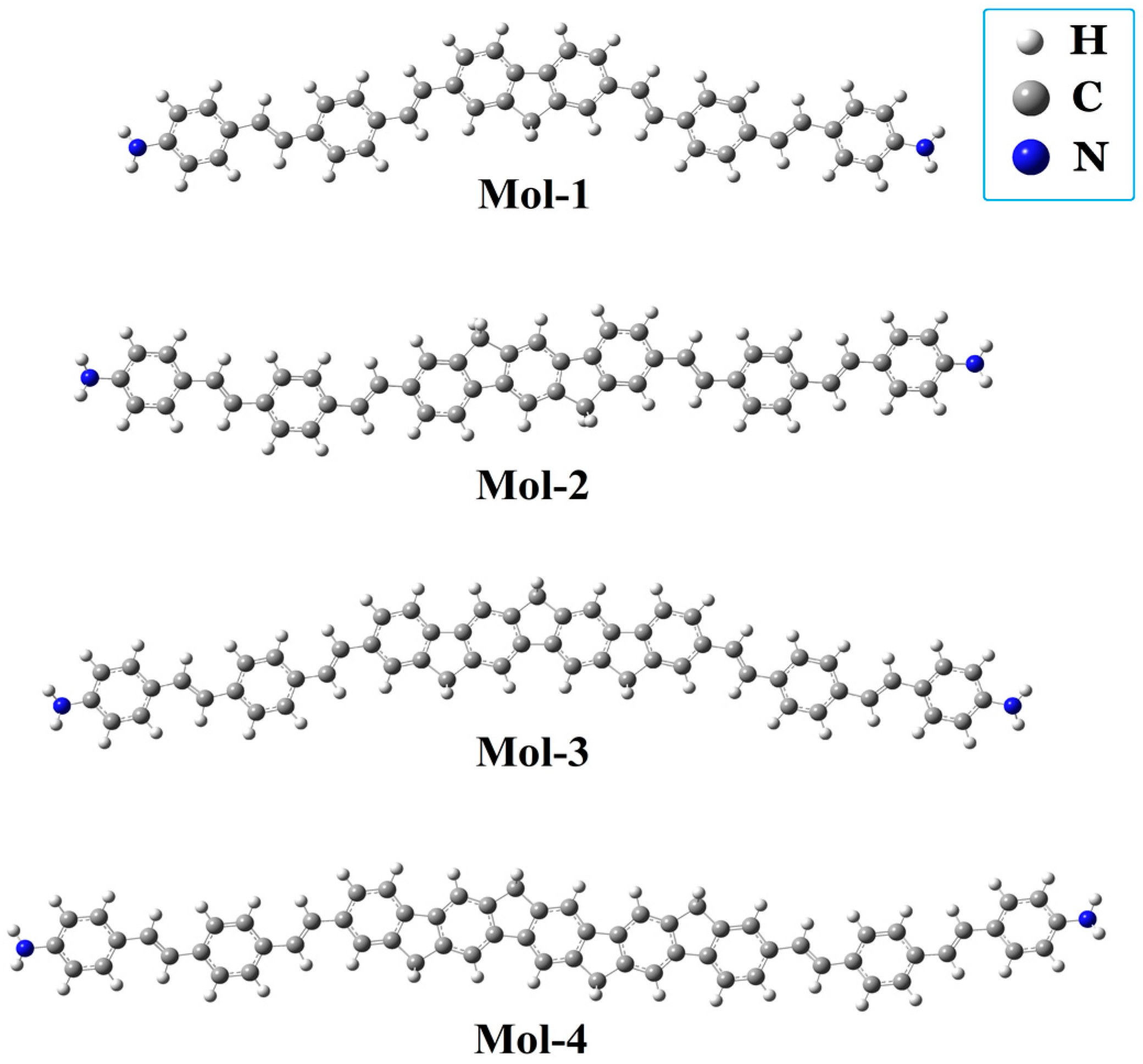
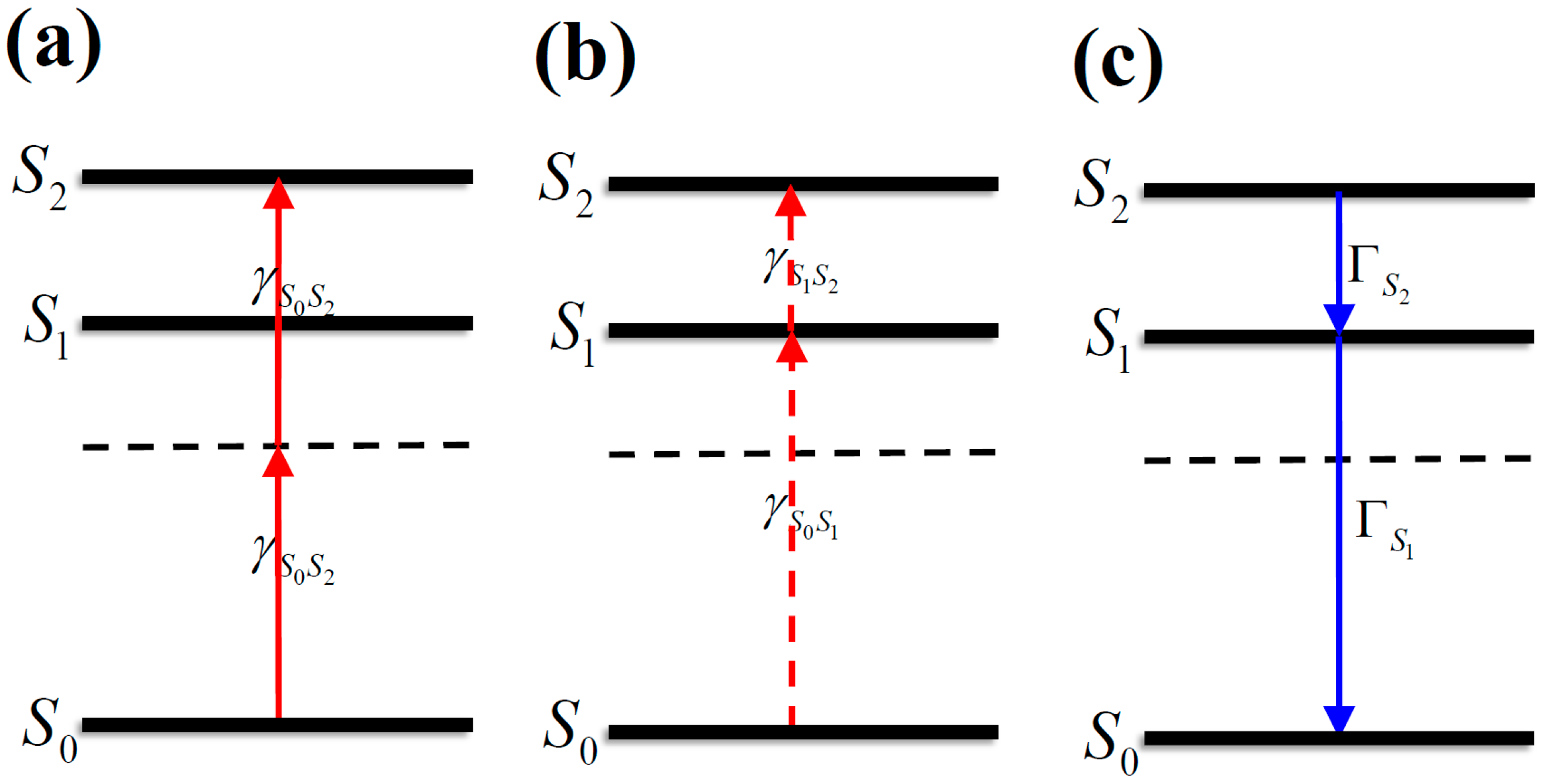
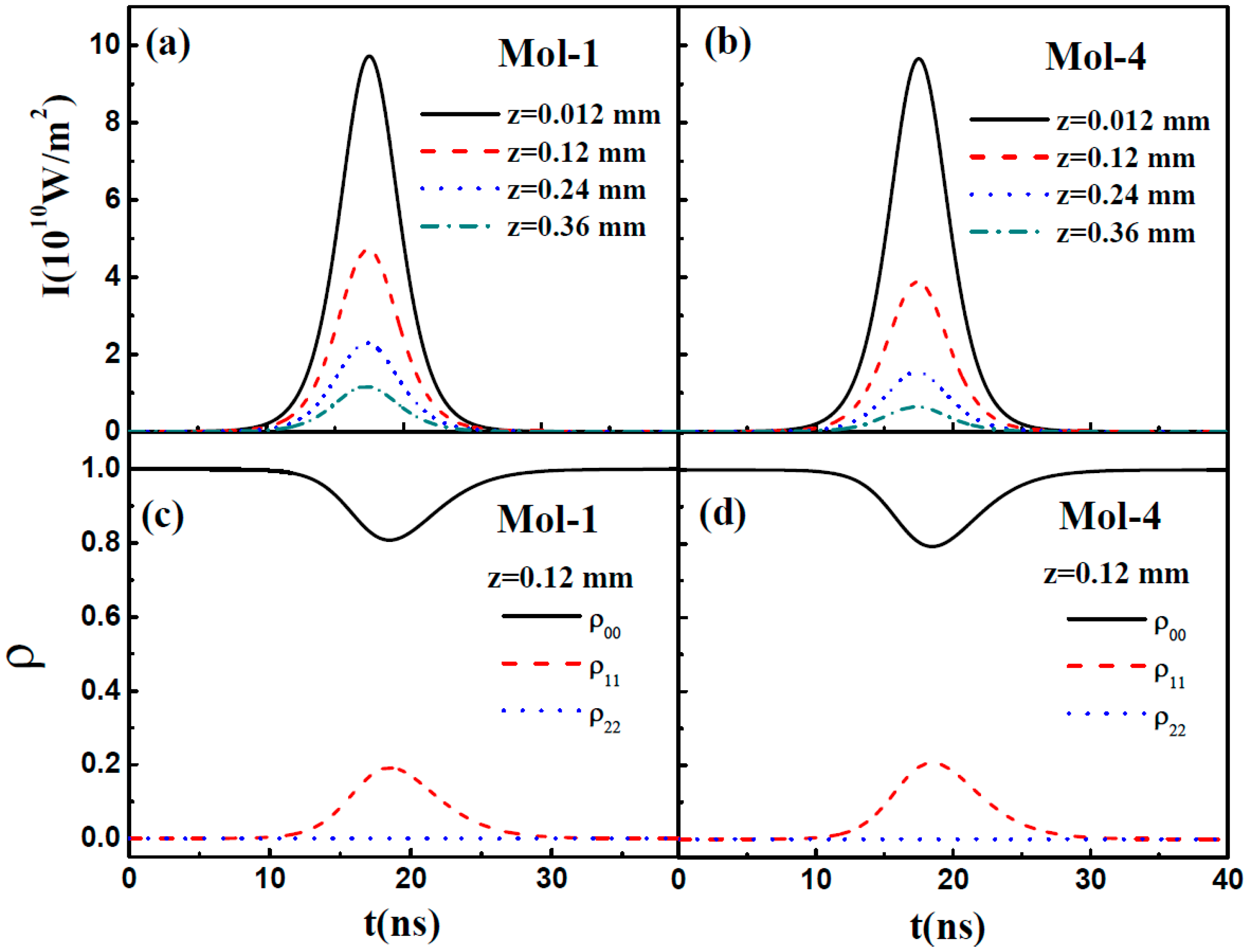
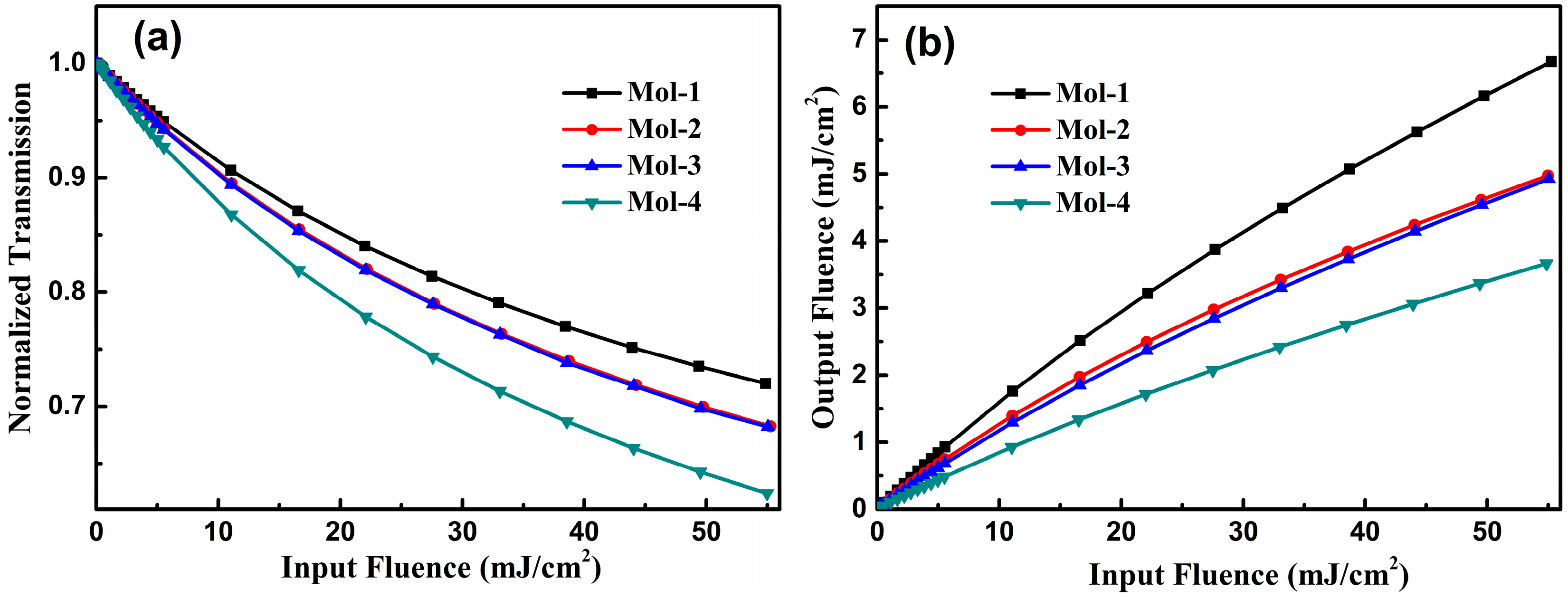
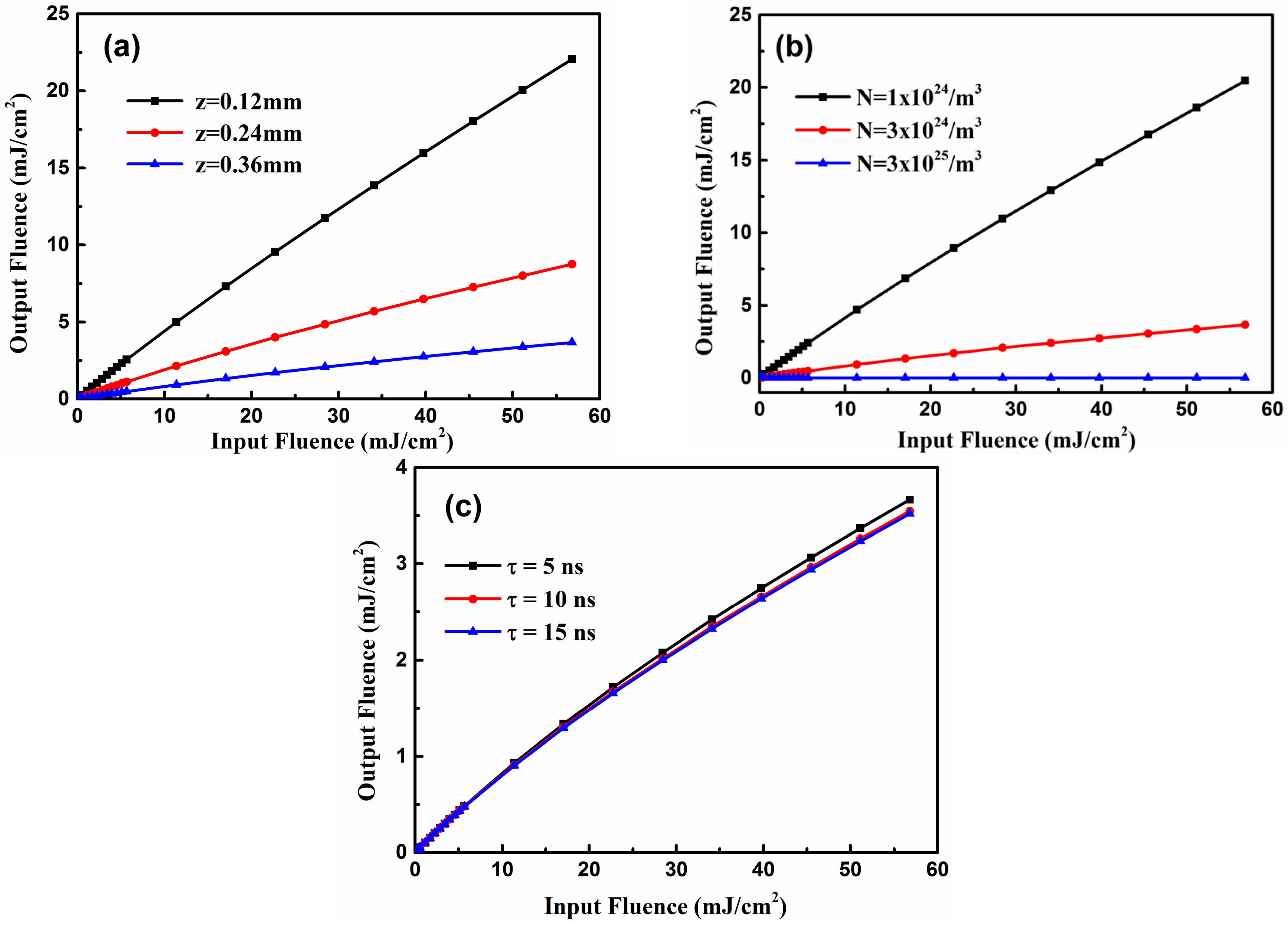
| Mol. | Excited State n | En0 | λn0 | δop | μ0n | μ1n | μ2n | μ3n | μ4n | μ5n |
|---|---|---|---|---|---|---|---|---|---|---|
| Mol-1 | 1 | 2.51 | 494 | 3.50 | 7.54 | 0.40 | - | - | - | - |
| 2 | 2.83 | 438 | 0.01 | 0.45 | 14.38 | 0.90 | - | - | - | |
| 3 | 3.10 | 400 | 0.09 | 1.12 | 4.32 | 0.48 | 0.02 | - | - | |
| 4 | 3.23 | 383 | 0.84 | 3.25 | 0.66 | 18.09 | 5.13 | 0.66 | - | |
| 5 | 3.33 | 372 | 0.07 | 0.97 | 0.94 | 3.68 | 12.19 | 0.04 | 0.33 | |
| Mol-2 | 1 | 2.53 | 490 | 4.10 | 8.12 | 0.15 | - | - | - | - |
| 2 | 2.83 | 438 | 0.00 | 0.07 | 15.97 | 0.19 | - | - | - | |
| 3 | 2.98 | 416 | 0.00 | 0.03 | 6.01 | 0.28 | 0.74 | - | - | |
| 4 | 3.12 | 398 | 0.80 | 3.62 | 0.01 | 22.36 | 11.47 | 0.10 | - | |
| 5 | 3.24 | 382 | 0.00 | 0.17 | 0.11 | 3.33 | 10.56 | 0.02 | 0.19 | |
| Mol-3 | 1 | 2.53 | 490 | 4.45 | 8.46 | 0.30 | - | - | - | - |
| 2 | 2.81 | 441 | 0.04 | 0.77 | 15.49 | 1.27 | - | - | - | |
| 3 | 2.90 | 428 | 0.08 | 1.10 | 5.40 | 0.25 | 0.22 | - | - | |
| 4 | 3.04 | 407 | 0.97 | 3.61 | 0.23 | 23.08 | 18.47 | 0.71 | - | |
| 5 | 3.16 | 392 | 0.00 | 1.26 | 1.38 | 7.53 | 8.88 | 0.25 | 0.55 | |
| Mol-4 | 1 | 2.55 | 486 | 5.10 | 9.03 | 0.06 | - | - | - | - |
| 2 | 2.81 | 441 | 0.00 | 0.07 | 15.63 | 0.62 | - | - | - | |
| 3 | 2.86 | 434 | 0.00 | 0.13 | 6.79 | 0.95 | 0.14 | - | - | |
| 4 | 2.99 | 415 | 0.92 | 3.54 | 0.20 | 16.15 | 30.72 | 1.59 | - | |
| 5 | 3.11 | 399 | 0.00 | 0.16 | 0.24 | 12.80 | 2.96 | 0.59 | 0.70 |
| Mol. | Mol-1 | Mol-2 | Mol-3 | Mol-4 | ||||||||
|---|---|---|---|---|---|---|---|---|---|---|---|---|
| z | α | β | σtp | α | β | σtp | α | β | σtp | α | β | σtp |
| 0.12 | 4.65 | 3.39 | 2.56 | 5.18 | 3.70 | 2.83 | 5.46 | 3.81 | 2.86 | 6.38 | 4.72 | 3.57 |
| 0.24 | 4.81 | 3.57 | 2.70 | 5.37 | 3.93 | 3.00 | 5.66 | 4.04 | 3.03 | 6.61 | 4.99 | 3.77 |
| 0.36 | 4.87 | 3.64 | 2.75 | 5.43 | 4.01 | 3.07 | 5.72 | 4.12 | 3.10 | 6.68 | 5.09 | 3.85 |
© 2017 by the authors. Licensee MDPI, Basel, Switzerland. This article is an open access article distributed under the terms and conditions of the Creative Commons Attribution (CC-BY) license ( http://creativecommons.org/licenses/by/4.0/).
Share and Cite
Zhang, Y.; Hu, W.; Zhao, L.; Leng, J.; Ma, H. Conjugation Length Effect on TPA-Based Optical Limiting Performance of a Series of Ladder-Type Chromophores. Materials 2017, 10, 70. https://doi.org/10.3390/ma10010070
Zhang Y, Hu W, Zhao L, Leng J, Ma H. Conjugation Length Effect on TPA-Based Optical Limiting Performance of a Series of Ladder-Type Chromophores. Materials. 2017; 10(1):70. https://doi.org/10.3390/ma10010070
Chicago/Turabian StyleZhang, Yujin, Wei Hu, Liyun Zhao, Jiancai Leng, and Hong Ma. 2017. "Conjugation Length Effect on TPA-Based Optical Limiting Performance of a Series of Ladder-Type Chromophores" Materials 10, no. 1: 70. https://doi.org/10.3390/ma10010070






